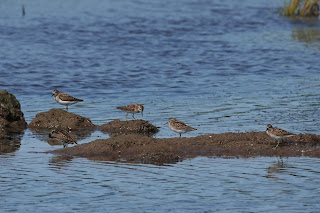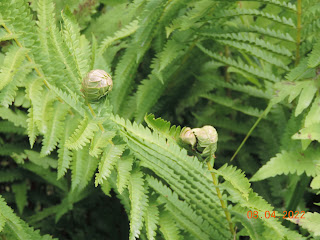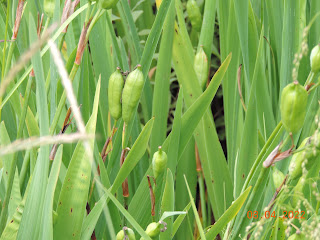August 5, 2022 (Friday)
To respond
by e-mail, please address your message to the information line editor, nelsonpoirier435@gmail.com .
Please advise the editor at nelsonpoirier435@gmail.com if any errors are noted in wording or photo
labelling.
For
more information on Nature Moncton, check the website at www.naturemoncton.com
Edited by: Nelson Poirier nelsonpoirier435@gmail.com
** Louise Nichols visited Ann's Acres beach (near Cape Tormentine) on
Thursday morning to do her first shorebird count of the season. She found
8 species of shorebirds -- both Greater and Lesser Yellowlegs, Least,
Semipalmated and White-rumped Sandpipers, Semipalmated Plovers, just 2
Black-bellied Plovers (who did not want their photo taken) and one Ruddy
Turnstone. In the salt marsh behind the beach, Louise heard Nelson
Sparrows in song, and saw some adult and juvenile Savannah Sparrows.
She also photographed some of the plant life in the salt marsh including some Sea
Lavender, Sea Rocket and Bittersweet Nightshade.
(Editor’s
note: Sea Lavender is a very popular nectaring plant, Sea Rocket is a very
pleasant tasting seaside nibble for humans, and Bittersweet Nightshade is
classed as toxic but have seen birds
eating it and don’t recall any reports of toxicity in other species.)
The most interesting part of the visit was a large
number of Bank Swallows -- over 100 -- flying over the beach and landing
on the sand. Louise was trying to photograph a group on the sand when 2
ladies approached with an off-leash dog that ran into the swallow group and
scattered them. Louise waited and many returned to the sand, and she was
able to get some photos.
**
Verica
LeBlanc sent some pleasant photos of visitors to her Miramichi yard, particularly visitors to flowering Coneflower, popular at this time of year.
A male Monarch Butterfly (note the two dark pheromone spots
arrowed to indicate male gender) visited
Coneflower on Wednesday and
was face to face with a bumblebee.
While
watering yesterday morning Verica came across a Tri-colored Bumblebee
resting and motionless, again on Coneflower to get an excellent photo showing
its field marks.
A Clouded
Sulphur Butterfly was on the plants and then did some puddling.
** Gordon Rattray joined Nature Moncton on their Wednesday night walk, led
by Louise Nichols. Gordon got to take pictures of several insects and
many plants.
Black Chokeberry (Aronia melanocarpa),
Bur-reed, Evening Primrose, Narrow-leaved Cattail, Tall Blue
Lettuce (Lactuca biennis), Clover Looper Moth, Evening Primrose
Moth, (editor’s note: the Primrose Moth has a very special/symbiotic
relationship with Evening Primrose as the adult nectars from the
flowers/pollinating and the larval caterpillars forage on the pods.) Gord also sends photos of Multicolored
Asian Lady Beetle (Harmonia axyridis), Northern Aerial
Yellowjacket (Dolichovespula
norvegicoides), Seven-spotted Lady Beetle (Coccinella
septempunctata), female Spotted Spreadwing Damselfly, Tricolored Bumble Bee (Bombus ternarius), White-faced
Meadowhawk, Seven-spotted Lady Beetle, (Coccinella septempunctata) and
Common Raven.
**Nice to get a return comment on Monarch
Butterfly use of butterfly weed.
Yolande LeBlanc has had Butterfly Weed in her garden beds for quite a few years. Some winters have killed them. She would plant more. One is on the south side of the house, and one is on the east side, under a bank of snow in winter and is sheltered. The ones Yolande has now are at least 5 years old. There are Monarch Butterfly caterpillars on them right now.
She has not had luck with the white variety of
Swamp Milkweed. They never came out after the first winter. She wonders if they went back to their mother variety thinking they are a hybrid.
She has been unable to count her Common Milkweed
plants, as there are too many and down a slope. Yolande estimates at least 1000!
**Aldo Dorio sends a photo of some seed pods that are of Sweet Flag Iris among cattail plants. If these parts are sliced in long section, a striking symmetrical arrangement of seeds is observed.
Aldo also photographed ‘rolled up’ structures on a fern.
A consult with Gart Bishop was indicated. Gart felt the fern to be an Interrupted Fern and has noted similar structures in the past. Gart felt this was probably a spider cache with eggs but not certain. It would be indicated to unroll one of the mystery forms which should readily reveal ‘who done it’.
**It’s Friday and time to muse on what the night sky next week will have in store for us courtesy of sky guru Curt Nason.
This
Week’s Sky at a Glance, 2022 August 6 – August 13
With the hot and muggy weather this summer there is nothing like an ice cream
to cool you down. If the night sky had a constellation honouring the ice cream
cone it would have to be the one we call Boötes (bo-OH-teez). Boötes is easy to
pick out because it is anchored by Arcturus, the fourth brightest star of the
sky. To identify the star, follow the arc of the Big Dipper’s handle to
Arcturus. This star is the bottom of the cone and the ice cream is to the
left of the Dipper’s handle, somewhat northward where it will stay cold and not
melt. The constellation can also pass for a kite or a necktie.
The name Boötes means ox driver but the constellation is often regarded as a
bear driver or a ploughman. With his hunting dogs, the Canes Venatici
constellation, he is seen chasing the two bears (Ursa Major and Ursa Minor)
around the pole. In Britain the Big Dipper is usually called the Plough, and in
mythology the goddess of agriculture requested Zeus to honour Boötes in the sky
for inventing the plough. I guess he is the John Deere of the night sky, or
perhaps Ernest Hamwi who popularized the edible ice cream cone at the 1904
World’s Fair in St. Louis.
Speaking of World’s Fairs, the 1893 and 1933 fairs were held in Chicago. To
commemorate technology, the lights for the latter fair were lit using a current
generated from photocells and the starlight of Arcturus. It was believed the
star was 40 light years distant, so the light reaching them would have been
emitted during the previous Chicago fair. We now know Arcturus is only 37 light
years away. Several observatories supplied starlight for the opening but,
considering the shape of the constellation, it is unfortunate that one of them
wasn’t the Lick Observatory in California.
This Week in the Solar System
Saturday’s sunrise in Moncton is at 6:07 am and sunset will occur at 8:41 pm,
giving 14 hours, 34 minutes of daylight (6:14 am and 8:44 pm in Saint John).
Next Saturday the Sun will rise at 6:16 am and set at 8:31 pm, giving 14 hours,
15 minutes of daylight (6:23 am and 8:34 pm in Saint John).
The full Moon is near Saturn on Thursday, an indication that the ringed planet
is close to opposition and rising soon after sunset. Jupiter rises around 10:15
pm midweek, followed by Mars two hours later, while in the west Mercury sets 50
minutes after sundown. Venus rises at 4:30 am to remind us that it is still the
most brilliant of all planets. Although hampered by bright moonlight, the
Perseid meteor shower will be the solar system highlight. It peaks next
Saturday morning but it should please a patient observer for a day or two
before and after.
The public observing at the Irving Nature Park in Saint John on August 5 or 6
has been postponed. On Sunday evening at 8 pm, tune in to the Sunday Night
Astronomy Show via the Facebook page or YouTube channel of Astronomy by the
Bay.
Questions? Contact Curt Nason at nasonc@nbnet.nb.ca.
Nelson Poirier
Nature
Moncton







.%20AUG.%204,%202022.%20LOUISE%20NICHOLS.JPG)







.%20AUG3,%202022,%20GORDON%20RATTRAY.JPG)



















